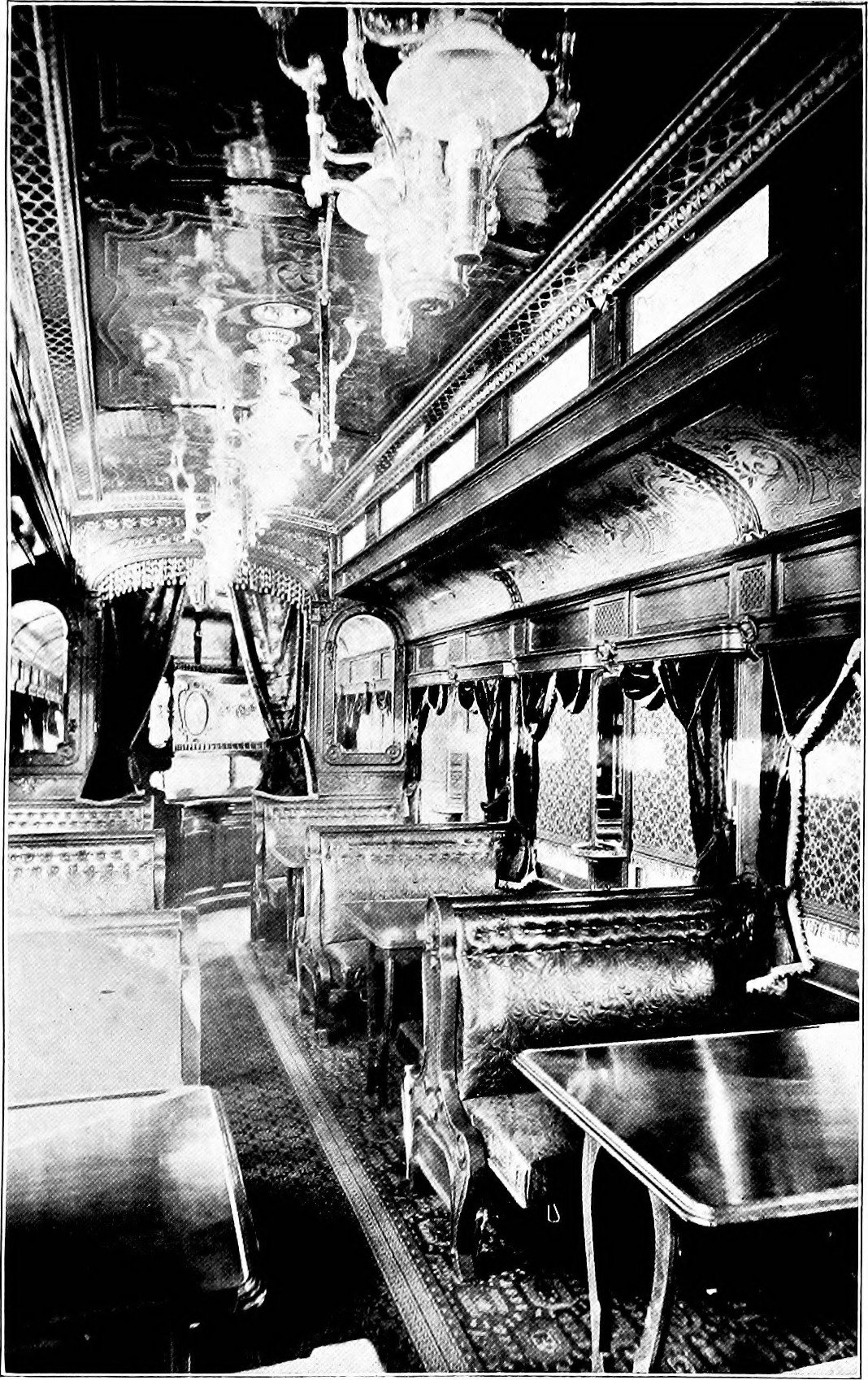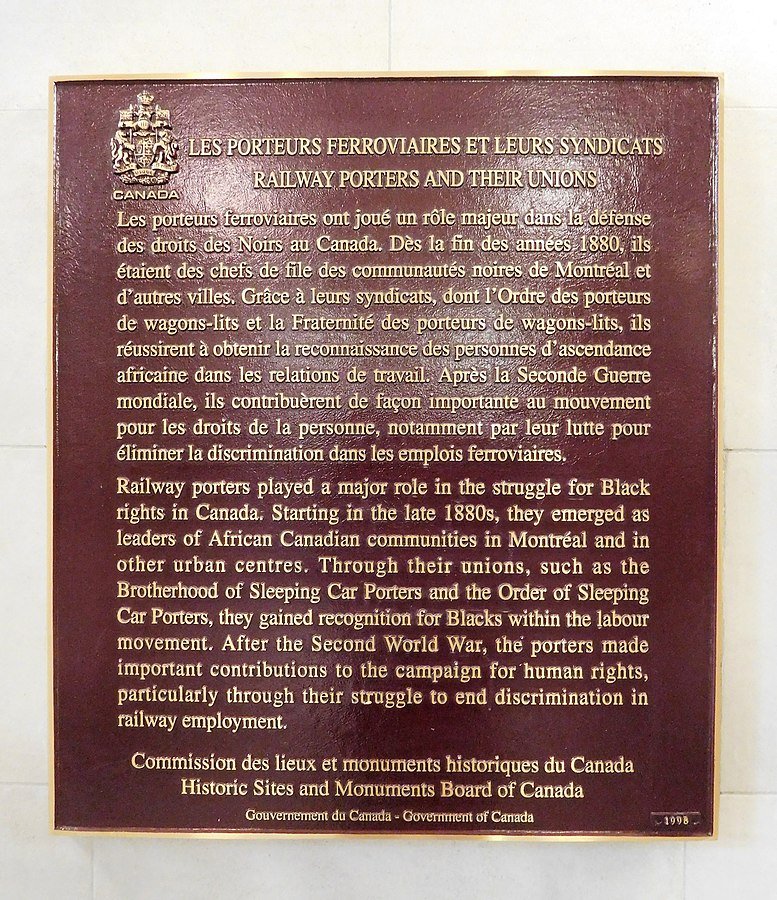
We’ve Been Here a Long Time
Sleeping car Porters
George Pullman
In the golden age of train travel customers could elect to travel by sleeping cars, a luxurious travelling option started by American engineer George Pullman in 1865. The service became known as Pullman Service. Chandeliers, dining facilities, and beds were included, but a large component of the journey depended upon the services of sleeping car porters, the majority of whom were Black men looking for employment after slavery ended. There were also many well-educated Black men who became porters as they were unable to work in their fields due to racist attitudes. Some of these men worked as porters temporarily over the summers, while others made a career out of it. They and their families were instrumental in establishing Black communities near CPR railway terminuses, such as Old Strathcona and Hogan’s Alley in Vancouver, and Little Burgundy in Montreal.
Interior of one of the first Pullman cars in which meals were served, ca. 1917. It was around this time that the Pullman cars began making cross-country journeys from the East Coast to California, following the joining of the Union Pacific and Central Pacific railroads at the Missouri River in Omaha. (Attribution: Internet Archive Book Images, No restrictions, via Wikimedia Commons, https://bit.ly/3phkKFU)
Porters Struggle for Equality
Railway Porters Historic Montreal Sign, Wikicommons
Wikicommons
A CPR porter’s duties included carrying luggage, setting up beds, ironing, shoe shining, food and beverage service, and round the clock availability to white passengers. The few white porters were paid more than their Black counterparts.
Under-paid and over-worked, these men were often subjected to racist attitudes and treatment, and had no job security. Complaints from passengers, true or not, were grounds for firing. They paid for their own uniforms and meals, and if a passenger stole something, that was the porter’s responsibility as well. Their shifts were long and sleeping conditions poor. If passengers rang, sleep was interrupted. Still, for many of these men, it was a desired position, given the lack of other opportunities, and for some it was a chance to travel and see other places.
Sleeping car porters became an influential group responsible for many societal changes. Though they were not allowed to join the “Whites Only” Canadian Brotherhood of Railway Employees (CBRE), a group of porters in Winnipeg formed the Order of Sleeping Car Porters. In 1919, their efforts resulted in having the Whites Only clause removed from the CBRE rules, though membership was still segregated. They also succeeded in giving porters the opportunity to move up the CPR job ladder and led the way to more equitable hiring practices.
Thanks to the work of these two unions, the Order of, and the Brotherhood of Sleeping Car Porters, there were many positive changes that came about through the collective agreement. One such benefit was the right to put up plaques in the sleeping cars they oversaw which stated their names. Prior to this, they were often called “George” referring to George Pullman. The union also negotiated better working conditions that included better sleeping conditions on the job, and fairer disciplinary measures.
Porter Fast Facts
Over 500 porters were recruited from the United States and the Caribbean
Between 1885 and 1895, with the completion of the Canadian Pacific Railway, the company tripled the number of sleeper cars
Between 1916 and 1919, despite anti-Black legislation in Canada and racism, if a Black man showed a CPR card with a promise of work, customs officials often turned a blind eye and allowed these men to enter the country
CPR porters unionized in 1945, but not before 36 were fired in the 1920s due to union activity connected to the US Brotherhood of Sleeping Car Porters
George V. Garraway was the first porter to move up the ranks to become the first Black Canadian train conductor
Stanley Grizzle, a former porter, became Canada’s first Black citizenship judge, and was also the president of the Toronto division of the BSCP
Rufus Rockhead saved his earnings as a porter to open his own jazz club in Montreal, “Rockhead’s Paradise,” which booked such artists as Louis Armstrong, Billie Holiday, Ella Fitzgerald, and Nina Simone
“C.P.R (Canadian Pacific Railway) – About 10 minutes, a short stop of the intercontinental trail when Black porter shouts “Up” one had to remount the train.”
Source: Library and Archives of Canada, 1933, Item #3242571
The Condition of Laboring Man at Pullman, 1894 Cartoon, Wikicommons
Coquitlam and the Sleeping Car Porters
Several families in Coquitlam have family members who were once porters for the CPR. You can learn more about them here:
Percy Perry
Percy Perry came from Trinidad to Winnipeg where he both studied and worked as a porter for CN. While in Winnipeg he met Norma, who had come from the Barbados to study nursing. Eventually the couple moved to British Columbia and were married. Here, Percy continued his education at UBC, subsequently working as a city planner for the Department of City Planning, New Westminster. He was responsible for the Westminster Quay Boardwalk. Percy and Norma lived in Coquitlam and raised their two children, Tara and Jason, near Riverview Hospital at a time when it was mostly rural.
Percy was an avid sportsman. While still in Trinidad, he played on their national soccer team. In Canada he was involved in his community through minor football, baseball, and as a sprint coach for the Coquitlam Cheetahs Track and Field Club for 15 years. During that time, the club produced five Olympians, (including his daughter), and several pro football players including Bret Anderson, Sandy Beveridge, and Doug Brown. He served as an advisor on the building of Coquitlam’s Town Centre Stadium which was built for the 1991 BC Summer Games, and the stadium was renamed Percy Perry Stadium in honour of the late Percy Perry.
Both Percy and Norma Perry were inducted into the BC Athletics Hall of Fame in 2002: Percy as a coach, Norma as a builder. In 2011, Percy was inducted into the Coquitlam Sports Hall of Fame.
Photo: Photograph of Percy Perry, center, assistant planner on the Ryall Park Bocci Ball court, with Bill Racanello and Joe Tollarao, coordinators of the building committee, 1975. (Photo by Peter Battistoni, New Westminster Museum and Archives, photo IHP10001-1526)
New Westminster Quay, opening day, 1987. Percy Perry worked for the Department of City Planning, New Westminster. He was responsible for the Westminster Quay Boardwalk. (Courtesy of Betty McVea fonds, New Westminster Museum and Archives, item IHP9563-0384)
Trainng/warmup jacket from the Coquitlam Cheetahs. (Courtesy of the Coquitlam Sports Hall of Fame)
Collection of newspaper clippings showing Percy’s success as a coach. (Courtesy of the Coquitlam Sports Hall of Fame)
Percy’s honourary membership plaque from the British Columbia High School Track & Field Association. (Courtesy of the Coquitlam Sports Hall of Fame)
Posthumous recognition of Percy’s success as a sports coach and trainer by the Coquitlam Sports Hall of Fame. (Courtesy of the Coquitlam Sports Hall of Fame)
Stopwatch used by Percy Perry during his tenure as head coach of the Coquitlam Cheetahs. (Courtesy of the Coquitlam Sports Hall of Fame)
Clipping from Tri-City News talking about Percy’s success with the Coquitlam Cheetahs. (Courtesy of the Coquitlam Sports Hall of Fame)
Lee and Roy Williams - Candace Knoll’s Uncles
Candace’s great uncle Lee Williams fighting for the rights of Sleeping Car Porters.
Candace Knoll is a long-time Coquitlam resident with a long list of accomplishments to her name. You can read more about Candace on the Coquitlam’s Black Community tab.
Candace has connections to the Sleeping Car Porters through her uncles in Winnipeg. Growing up, Candace remembers the stories about her Uncles Lee and Roy Williams, who were part of the Sleeping Car Porter’s struggle for unionization and equality. She recalls the pride and respect porters were given by the community, They were always well-dressed, respectful, honest, and respectable members of the community whose jobs allowed their families to become solidly middle-class.
Uncle Lee has another claim to fame, as he received a provincial award in Ontario for his advocacy work as a member of the porter’s union. On one working trip, Lee found Prime Minister Diefenbaker in one of his cars. He seized the opportunity to speak to Diefenbaker, (a captive audience), about issues within the CPR system and the problems that porters had to face. This led directly to reforms within the CPR and a federal inquiry into the Sleeping Car Porter’s livelihoods. He received the Queen’s Golden Jubilee Medal, which is awarded to Canadians who made “outstanding and exemplary contributions to their communities or Canada as a whole.” He is also featured in the National Film Board film “The Road Taken” about the train car porters. When he was 94 years old, Lee was awarded the honorary degree of Doctor of laws from York University.
Additionally, Uncle Roy was one of the earlier emigres to Hogan’s Allery/Strathcona, a predominately Black community at the end of the CPR line that included many Sleeping Car Porters and their families. He moved to the area after starting the Sleeping Car Porter’s Chapter in Calgary.
Photo: Lee Williams speaking at a meeting of the Black Porter’s union. Lee was active in the Porter community until his death, advocating for equal pay and rights.
William Theophlus Brown
Bill Brown, Totem 58 94, UBC Archives.
William Theophlus Brown, or Bill Brown as he was known, was born in Hawkinsville, Georgia during the segregation era. His mother had a restaurant and his father worked in the railway yards in a racially segregated community. the family were poor, and suffered from overt racism, his grandfather having been killed by the KKK for “looking at someone.” His grandmother was left to raise ten children on her own.
Bill made his way through school, graduating from Tuskegee Institute, a Black college in Alabama, but faced very limited opportunity in the Southern USA. He took a professor’s advice and applied to McGill University in Montreal where he achieved his PhD in biochemistry, defending his thesis in French, English, and German.
It was during this time that Bill worked as a porter for the CN during summer months to help pay for his education and to use the opportunity to indulge in his passion for travel. While at McGill he met Rosemary Wedderburn, from Jamaica. The two married and both went on to illustrious careers; Rosemary Brown becoming a famous Canadian politician, and Bill becoming world renowned for his work and research in psychopharmacology and lithium. He was among the first to use lithium as a treatment for mental illness. Bill also received his medical degree from UBC, and became a teaching fellow there, and Department Acting Head from 1983-1985. While at UBC, he was elected Class President. He was also president of the Canadian Psychiatric Association in 1984.
Bill often travelled out to Riverview Hospital in Coquitlam as part of his private practice, where he was well-liked and respected by both patients and other staff. His daughter, Cleta, retired Vancouver lawyer, remembers going with him to play on the Riverview grounds with her brother. She says that “their father’s example showed them how to treat people humanely, with dignity and with intelligence.”
Cleta also says that the family almost moved to the Ranch Park subdivision of Coquitlam, when it was first built, but in the end did not close any house deals there.















